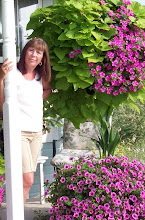
Praise God from whom all blessings flow . . .
I cannot keep those words out of my head this afternoon. That old hymn, which I've heard and sang countless times over the years, kept coming back to me over and over as Lu and I surveyed the lack of damage from the hard freeze we endured last night. I can only say that the bare minimum of destruction was the Lord hearing my prayer and blessing me with His kindness. I had left my perennials, shrubs, and trees in His hands, not covering anything.
Usually, you could find me in a frantic race with my blankets and quilt batting and bags of mulch, trying to wrap up everything. But, when I heard that our night temps were to be in the low 20's, I knew not I alone could win that battle. That's when I turned over the grief of losing my gardens to a killing frost and gave my trepidations to the Lord.
Usually, you could find me in a frantic race with my blankets and quilt batting and bags of mulch, trying to wrap up everything. But, when I heard that our night temps were to be in the low 20's, I knew not I alone could win that battle. That's when I turned over the grief of losing my gardens to a killing frost and gave my trepidations to the Lord.
Around one 0'clock this afternoon, I leashed Lu and we went for a walk around the property, inspecting garden beds. To my amazement, there's been very little damage. Even my most tender perennials seem to have come through with flying colors. On our walk, I discovered my Cameo Flowering Quince in bloom. Oh is it lovely! Its gorgeous, double apricot blooms against its kelly green foliage just takes my breath away.
I remember buying it from a discount table. The poor thing was barely a foot tall with four or five meager branches, just clinging to life. Of course I had to save it. What a beauty its turned out to be this spring. The botanical name of this prize is chaenomeles speciosa and it is grown for its abundant early spring flowers. Right along side forsythia, its one of the first spring shrubs to bloom and then bears green/yellow fruits. The fruits are fairly tasteless but have a high amount of pectin and when combined with blueberries, raspberries, grapes, or blackberries which are low in pectin, can actually allow one to make jelly without adding extra pectin.
Most flowering quince are hardy to zone 5. They are a great choice for growing a dense hedge. The fruits are often used as a pomander for closets because of their exceptionally strong fragrance. Plant in a sunny location in rich soil. Quince do well with a yearly spring feeding of rotted compost and bonemeal.
Further to the back of our property, Lu and I happened upon Dave's Keiffer semi-dwarf pear in bloom. He planted the Keiffer last fall along with a Summercrisp. The sad news is, Dave did this b
 ecause fire blight infected our elderly pear tree. This pear tree was on the property when we bought it but I would estimate it to be close to 100 years old. At some point in the past, either lightening or disease caused this tree to die out and offshoots grew in the place of the original tree. But, having said that, it was still a magnificent specimen. We will be so sorry to lose it as half of the tree died with the fire blight. Unfortunately, I don't think this tree made it through the winter. There aren't any leaves and its bark is very black.
ecause fire blight infected our elderly pear tree. This pear tree was on the property when we bought it but I would estimate it to be close to 100 years old. At some point in the past, either lightening or disease caused this tree to die out and offshoots grew in the place of the original tree. But, having said that, it was still a magnificent specimen. We will be so sorry to lose it as half of the tree died with the fire blight. Unfortunately, I don't think this tree made it through the winter. There aren't any leaves and its bark is very black.However, on a happier note, a sapling from the old tree grew up in our blackberry patch and it has leaves and flowers, a strong fellow! Thank you God for all your blessings!





